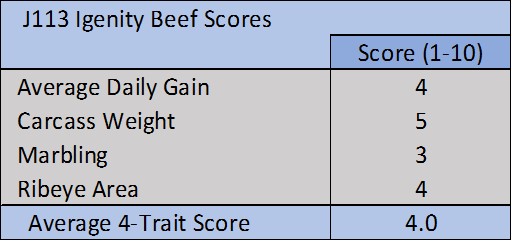Posted February 13, 2024
Last week, we introduced the fall-born steer calf pictured below. He was part of a Red Angus EPD comparison project that matched up one high-growth/high-carcass sire against two low-growth/lower-carcass sires. This calf was one of 26 total calves in the study. He impressively ranked third against his contemporaries for weaning weight on a 205-day adjusted basis. His weaning weight ratio was 111.
Next, we asked readers to guess whether this calf, tagged J113, was sired by the high genetic merit sire or one of the two lower genetic merit sires.

Most would say this is a solid-looking calf (though green in the picture), and his weaning weight ratio in a sizable contemporary group is notable. However, this calf was sired by one of the project’s low-growth/low-carcass sires, and that reality showed up in his own genetics. When tested with Igenity Beef®, he ranked at or below industry average for the downstream traits shown in the table below. A score of 5 is considered average.

Next, we evaluate J113’s feedlot and carcass performance (in the table below). He did not perform too poorly, considering he and his herd mates endured difficult winter weather in the Nebraska feedlot where they were finished. Yet he was no match for the top sire group, which gained a half pound more per day, produced significantly more live and carcass weight and graded better to boot. J113’s individual carcass value was $156.81 lower than the average of his 13 contemporaries sired by the high-growth/high-carcass Red Angus sire.

In the end, he performed in line with his genetics. And genetics are hard, if not impossible, to assess through visual appraisal of a young animal. The main takeaway from this case study is that Red Angus EPDs do a good job of predicting real-world cattle performance. J113’s sire is a lower-ranking growth and carcass bull. His Igenity Beef scores pegged him at or slightly below industry average. Matching those two pieces of genetic data, J113’s feedlot and carcass performance came in well below that of his contemporaries who were sired by a higher growth and carcass merit bull.